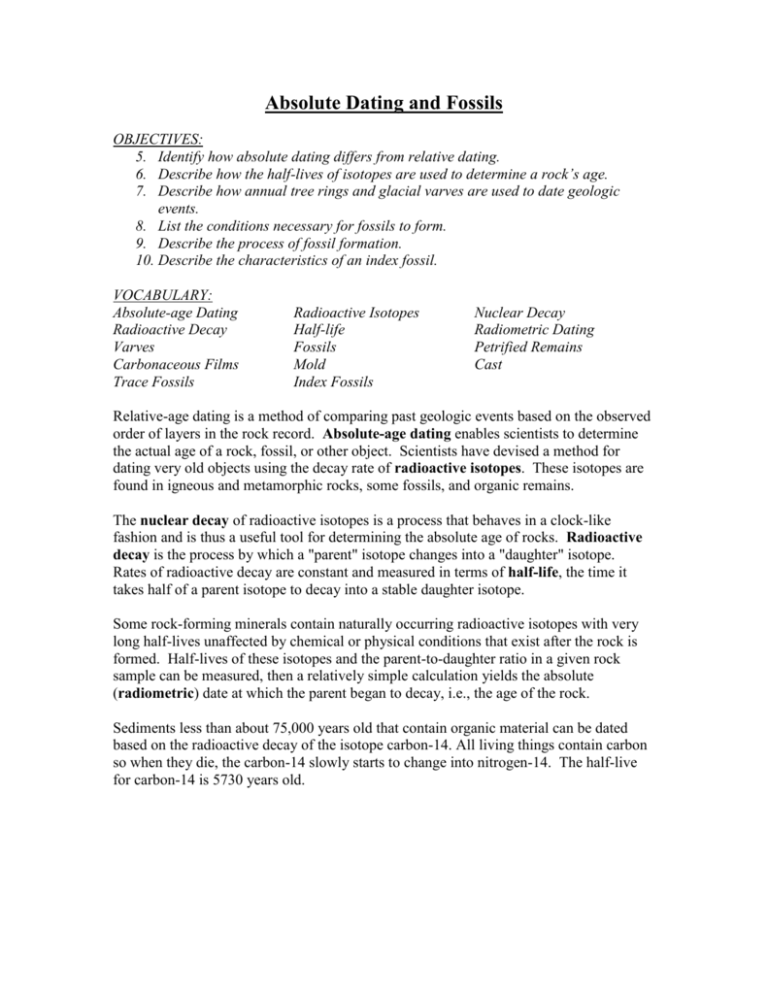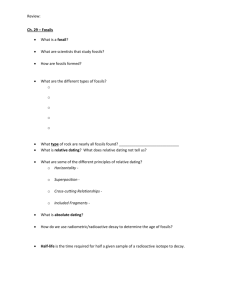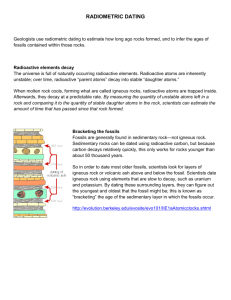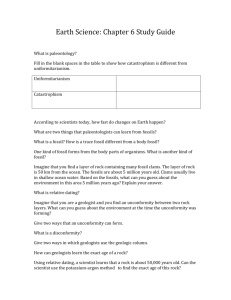Absolute Dating and Fossils
advertisement

Absolute Dating and Fossils OBJECTIVES: 5. Identify how absolute dating differs from relative dating. 6. Describe how the half-lives of isotopes are used to determine a rock’s age. 7. Describe how annual tree rings and glacial varves are used to date geologic events. 8. List the conditions necessary for fossils to form. 9. Describe the process of fossil formation. 10. Describe the characteristics of an index fossil. VOCABULARY: Absolute-age Dating Radioactive Decay Varves Carbonaceous Films Trace Fossils Radioactive Isotopes Half-life Fossils Mold Index Fossils Nuclear Decay Radiometric Dating Petrified Remains Cast Relative-age dating is a method of comparing past geologic events based on the observed order of layers in the rock record. Absolute-age dating enables scientists to determine the actual age of a rock, fossil, or other object. Scientists have devised a method for dating very old objects using the decay rate of radioactive isotopes. These isotopes are found in igneous and metamorphic rocks, some fossils, and organic remains. The nuclear decay of radioactive isotopes is a process that behaves in a clock-like fashion and is thus a useful tool for determining the absolute age of rocks. Radioactive decay is the process by which a "parent" isotope changes into a "daughter" isotope. Rates of radioactive decay are constant and measured in terms of half-life, the time it takes half of a parent isotope to decay into a stable daughter isotope. Some rock-forming minerals contain naturally occurring radioactive isotopes with very long half-lives unaffected by chemical or physical conditions that exist after the rock is formed. Half-lives of these isotopes and the parent-to-daughter ratio in a given rock sample can be measured, then a relatively simple calculation yields the absolute (radiometric) date at which the parent began to decay, i.e., the age of the rock. Sediments less than about 75,000 years old that contain organic material can be dated based on the radioactive decay of the isotope carbon-14. All living things contain carbon so when they die, the carbon-14 slowly starts to change into nitrogen-14. The half-live for carbon-14 is 5730 years old. Naturally occurring materials can also be used to help determine the age of an object or event: o Tree rings Accurate in climates where there is a lot of growth in the spring, and less growth in the winter The widths of the tree rings are directly related to the climatic conditions during growth periods o Glacial deposits Ice would melt in the summer, causing large volumes of flowing water to be released Fine glacial sediments were picked up by the moving water and carried downstream where they were deposited in large lakes These deposits were light in color and relatively thick compared to the thinner, darker colored sediments of winter These bands of alternating sediments are called varves and can be read in the same way as tree rings Fossils are the evidence or remains of once-living plants or animals. The provide evidence of a wide variety of life forms, how those life forms have undergone changes, and what the environmental conditions were like in the past. In order for an organism to be preserved as a fossil, certain circumstances will better the chance of that happening: o The body of the dead organism must be protected from scavengers and microorganisms o This occurs if the body is buried quickly by sediments (fossils will be found in sedimentary rock) o Organisms have a better chance of being preserved as a fossil if they have hard parts such as bones, shells, or teeth There are four main ways in which fossils are formed: o Petrified remains Hard and rock like Some or all of the original materials in the remains have been replaced by minerals For example, a solution of water and dissolved quartz may flow through the bones of a dead organism. The water dissolved the calcium in the bone and deposits quartz in its place. Quartz is harder than calcium, so the petrified bone is rocklike. o Carbonaceous films Organisms contain carbon and sometimes only this carbon remains behind As the organism is buried under sediments, gases and liquids are forced to leave the body, leaving behind a thin film of carbon residue, forming an outline of the original organism o Molds and Casts Over time, sediments cover a dead organism and begin to harden, forming rock. Pores in the rock let water and air reach the shell or hard part and it then decays, leaving behind a cavity called a mold Other sediments may fill the cavity, harden into rock, and produce a cast of the original object o Trace fossils These are indirect evidence of plant and animal life Include tracks, burrows, stomach contents, solid waste material, nests Some fossils are more useful than others in relative-age dating. Index fossils are remains of plants or animals that can be used by geologists to correlate rock layers over large geographic areas or to date a particular rock layer. An index fossil is easily recognized, abundant, and widely distributed geographically. It must also have lived during a short period of time.






